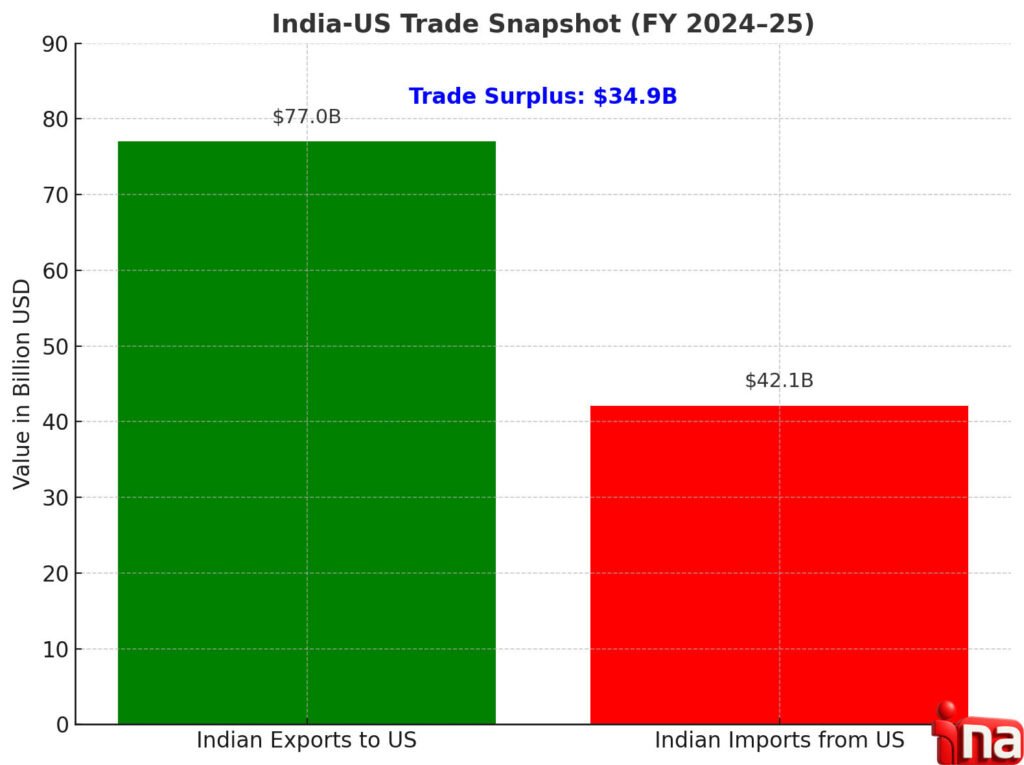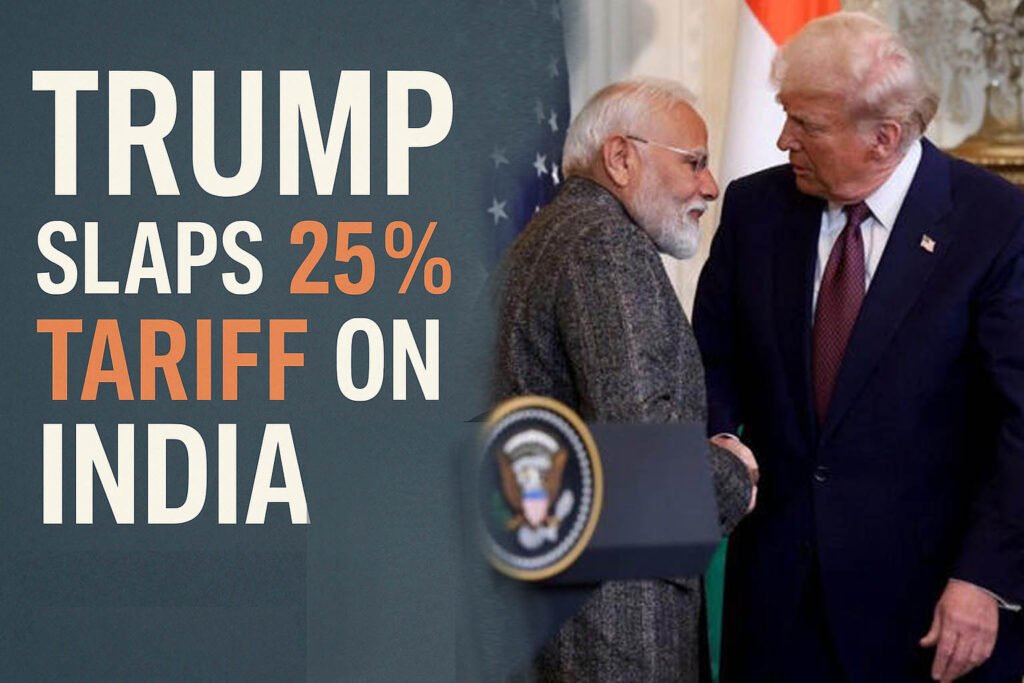Amid Trade Deadlock and Russian Oil Purchases, India Faces U.S. Tariff Heat
The United States, under President Donald Trump’s administration, has imposed a 25% tariff on Indian imports effective August 1, 2025. This dramatic escalation in trade policy comes amid a prolonged deadlock in bilateral trade negotiations and intensifying geopolitical pressure over India’s energy dealings with Russia. The decision marks a turning point in India–US trade relations, with potential long-term implications for economic, diplomatic, and strategic ties.
Timeline of Events Leading to the Tariff
| Date | Event |
|---|---|
| April 2, 2025 | Trump announces global tariff hike, targeting India with up to 27% duty on goods |
| May–June 2025 | India and US engage in mini-deal trade negotiations focused on agriculture, dairy |
| July 9, 2025 | 90-day pause on tariffs ends; deadline extended to August 1 |
| July 24–28, 2025 | Talks stall over non-tariff barriers, food safety rules, dairy trade language |
| July 29, 2025 | Trump confirms 25% tariffs on India effective August 1; additional penalties threatened for Russian oil imports |
The Immediate Trigger: Trade Deficit and Tariff Friction
In a post on his platform Truth Social, President Trump justified the move by stating:
“WE HAVE A MASSIVE TRADE DEFICIT WITH INDIA!!!”
“India has the most strenuous and obnoxious non-monetary trade barriers of any country… They will be paying a tariff of 25%, plus a penalty for buying oil from Russia.”
India’s trade surplus with the US stood at $35 billion in FY 2024–25, with Indian exports at $77 billion and imports from the US at $42.1 billion. Trump, who has long accused India of “unfair” trade practices, had previously labelled it the “tariff king”, alleging disproportionately high duties on American goods such as Harley Davidson motorcycles, medical equipment, and tech components.

The fresh tariffs follow a 27% tariff threat issued in April, later put on hold to allow time for trade negotiations. Trump’s latest decision reflects frustration with the lack of progress, particularly over India’s hesitancy to fully open up agriculture and dairy markets to American firms.
The Dairy Dilemma: Core of the Stalemate
Negotiations were derailed mainly over India’s reluctance to lift long-standing restrictions on imported dairy products, citing religious and regulatory concerns. American companies had been seeking market access for processed dairy and genetically modified animal feed, but Indian negotiators reportedly objected to product labelling norms and traceability standards.
“There was an understanding to allow limited dairy imports, but disagreements emerged over how products should be labelled, especially regarding animal feed origin,” said a senior Indian trade official to Doordarshan News on July 26.
The Indian dairy sector, largely run by small-scale farmers and cooperatives like Amul, has strong political backing. Any perceived concession is seen as risking both domestic livelihoods and ideological ground.
Geopolitical Overlay: Russia-Ukraine War and Energy Security
Beyond trade, a major factor behind the tariff imposition is India’s continued purchase of Russian oil and weapons systems, despite global efforts to isolate Moscow amid its prolonged war in Ukraine. India imported $56 billion worth of Russian energy in FY 2024–25, making it one of the largest global buyers of Russian crude.
President Trump cited this as a breach of strategic trust:
“They [India] have always bought a vast majority of their military equipment from Russia… At a time when everyone wants Russia to stop the killing in Ukraine—all things not good!”
The US President has signalled additional penalties may soon be imposed on Indian entities engaging in oil deals with sanctioned Russian firms. This follows a June statement by US Senator Lindsey Graham, who proposed authorising tariffs up to 500% on countries purchasing Russian energy.
Meanwhile, the EU’s secondary sanctions in early July targeted India’s Vadinar refinery, owned by Nayara Energy (a Rosneft-linked company), increasing Western scrutiny of India’s energy ties with Moscow.
Domestic Response and Strategic Calculations
Indian officials have so far maintained a cautious stance, framing energy imports as a matter of national security and sovereign policy.
“India’s energy needs cannot be held hostage to external political agendas,” said External Affairs Minister S. Jaishankar on July 25, speaking to All India Radio.
India’s Ministry of Commerce and Industry, while acknowledging the tariff blow, stated that negotiations would continue in the second half of August in New Delhi, aiming to bridge the gap on agriculture, tech exports, and energy diplomacy.
Meanwhile, Indian exporters in sectors such as textiles, pharmaceuticals, and auto components have urged the government to consider reciprocal duties or WTO arbitration if talks fail again.
What’s at Stake: Economic Impact and Global Trade Dynamics
Short-term Impact:
- Exporters fear loss of competitiveness in the US market.
- Sectors like IT services, engineering goods, pharma, and specialty chemicals may face price shocks.
- Possible rerouting of trade via third-party countries (Vietnam, UAE) to avoid tariff walls.
Long-term Risk:
- Erosion of goodwill in India–US strategic relations.
- Delay or dilution of potential free trade agreement (FTA) discussions.
- Intensified domestic protectionism in India in response.
| India–US Trade Snapshot (FY 2024–25) |
|---|
| Indian exports to US |
| Indian imports from US |
| Trade Surplus in India’s favor |
| Russian energy imports by India |
President Trump’s 25% tariff decision is a culmination of longstanding frustrations over trade imbalance, India’s high non-tariff barriers, and geopolitical tensions stemming from the Ukraine crisis. While the move may be intended as leverage for accelerating a mini-deal, it risks alienating one of the United States’ key democratic allies in Asia. For India, the response must balance economic realism with strategic autonomy, especially amid global fragmentation and election-driven policy unpredictability in Washington.
With next-stage negotiations scheduled for August in New Delhi, the coming weeks will be critical for either mending ties or deepening the divide.


